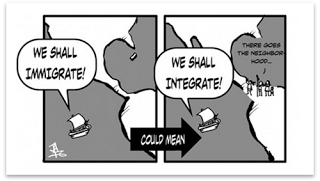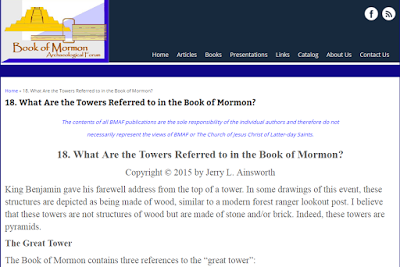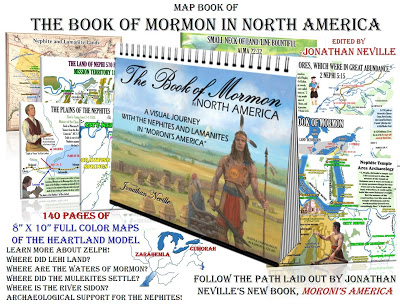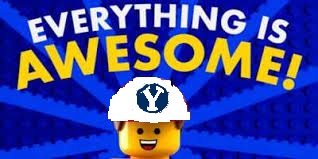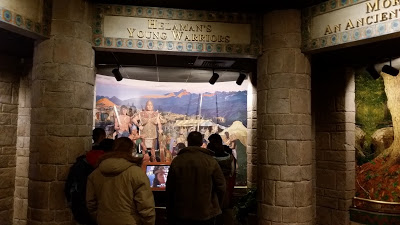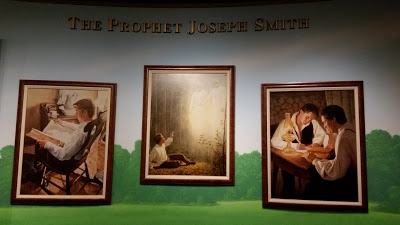Letter VII and the hemispheric model
Usually that claim is made without further analysis, as if Letter VII itself describes a hemispheric model. But it doesn’t.
The only thing Letter VII establishes is that Cumorah–the Cumorah of the final battles, the Cumorah of Mormon 6:6, etc.–is the hill in New York where Joseph obtained the plates.
It’s true that some contemporaries of Joseph Smith described a hemispheric model. There was quite a bit of speculation about where the Book of Mormon events took place, but zero speculation about any site for Cumorah other than New York. The 1879 Orson Pratt footnotes are a perfect example. I have a separate post on that scheduled for later this week.
It is because of this unanimous and universal understanding about the New York Cumorah that I say Cumorah is a pin in the map. It’s the touchstone between our modern world and the world of the Nephites and Jaredites. It’s the one sure thing we can rely on, and it was given to us unambiguously and definitely by Joseph and Oliver in Letter VII.
As I’ve documented on this blog and elsewhere, some LDS scholars and educators nevertheless continue to insist that Cumorah is not in New York and cannot be in New York. They almost don’t care where it is so long as it is not in New York.
I attribute their approach to Mesomania. Others attribute it to stubbornness, academic pride, and similar concerns.
_____________________
Back to the hemispheric model argument.
The reason people link Letter VII to the hemispheric model is not because Oliver or Joseph did, but because the scholars have created the link in their minds.
They insist that most of the events in the Book of Mormon took place in Central America. Therefore, they reason, a New York Cumorah means a hemispheric model; i.e., the Nephites would have had to travel all the way from Central America to New York, an idea that they ridicule as absurd.
Actually, I tend to agree with them on that point. But the absurdity arises from the Mesoamerican setting, not from the New York Cumorah.
_____________________
Maybe I should start referring to Mesoamerican proponents as anti-Letter-Seveners. These anti-Letter-Seveners have basically suppressed Letter VII for decades. Now, thanks in part to the Joseph Smith Papers project, Letter VII is available to anyone with Internet access. Thousands of Church members are discovering it for the first time.
So what does a good anti-Letter-Sevener do?
Try to link it to the discredited hemispheric model.
Let’s pretend we’re anti-Letter-Seveners for a minute.
We can observe that right in Letter VII, Oliver Cowdery described Joseph Smith’s thoughts as he approached the hill to get the plates. Joseph was thinking about the value of the plates and how they would relieve him of poverty. On the other hand, he was commanded to work with the plates only for the glory of God. But he could sell the valuable history for a lot of money. As Oliver wrote, “to use his own words it seemed as though two invisible powers were influencing, or striving to influence his mind.”
Oliver observed one reason the history would be valuable: “A history of the inhabitants who peopled this continent, previous to its being discovered to Europeans by Columbus, must be interesting to every man; and as it would develope [develop] the important fact, that the present race were descendants of Abraham, and were to be remembered in the immutable covenant of the Most High to that man, and be restored to a knowledge of the gospel, that they, with all nations might rejoice, seemed to inspire further thoughts of gain and income from such a valuable history.”
While we’re in the anti-Letter-Sevener mode, we will interpret this to mean that Oliver and Joseph thought the plates were describing a hemispheric setting for the Nephites and the Jaredites.
Let’s step out of anti-Letter-Sevener mode and look at the facts.
Joseph entertained these thoughts before he translated the plates. Before he even obtained them. Oliver is not representing what the plates said, only what Joseph thought they would, or might, say.
Scholars can debate about what Oliver meant here; i.e., does “peopled this continent” mean North America, or all of the Western Hemisphere? What did he mean by saying “this continent” was “discovered to Europeans by Columbus?” Those are the type of debates scholars love because there is never any resolution.
But the debate is irrelevant because Oliver was not writing about what the record actually contained; he was writing about what Joseph thought it would contain before he translated a single word.
Oliver’s description of what Joseph was thinking before he obtained the plates is irrelevant to what Joseph and Oliver taught after they have translated the plates.
________________________
In Letter VII, Oliver referred to the Indians as “red men” when he wrote this:
“the land was left to the possession of the red men, who were without intelligence, only in the affairs of their wars; and having no records, only preserving their history by tradition from father to son, lost the account of their true origin, and wandered from river to river, from hill to hill, from mountain to mountain, and from sea to sea, till the land was again peopled, in a measure, by a rude, wild, revengeful, warlike and barbarous race.-Such are our Indians.”
This passage could lead an anti-Letter-Sevener to claim that Oliver was referring to all indigenous Native Americans throughout the hemisphere. That might be difficult to believe, but the anti-Letter-Seveners have honed their rhetorical skills defending their Mesoamerican theories. Transforming Oliver’s sentence into a full-blown hemispheric model would not be any more difficult than what they’ve done with the Times and Seasons, Wentworth letter, Zelph account, etc.
But you can see for yourself that Oliver didn’t invoke Central or South America.
Oliver’s eight letters were part of a running correspondence with W.W. Phelps, who was living in Missouri at the time. Phelps wrote 11 letters to Oliver’s 8. The letters were published in the Messenger and Advocate between October 1834 and October 1835.
In his second letter, published in December 1834, Phelps wrote a poem titled “The Red Man.” [Note: the origins of the term “red man” are not clear, but likely involved the use of red pigment by certain tribes, such as a tribe in Newfoundland that used red ochre to paint their bodies, houses, canoes, etc. Europeans called them the “Red Indians.” I’m not aware of any example of the term being used for indigenous people in Central America.]
At the conclusion of his poem, Phelps wrote this:
“Besides the Delawares, Shawnees, Kickapoos, Wyandots, Pottowattomies, Senecas, Osages, Choctaws, Cherokees, Kaskaskias, Kansas, &c. &c. which our nation and the missionaries are domesticating as they are gathered, upon the southern limits of the land of Israel, the Pawnees, the Sioux, the Rickarees, the Mandans, the Nespersees, the Blackfeet, the Sacs, the Foxes, and many other tribes, rove and hunt from prairie to prairie, from river to river, from hill to hill, and from mountain to mountain, and live, and are blessed before the face of heaven daily as well as their contemporary whites; and, perhaps I may add, are as justifiable before God, as any people on the globe, called heathens.”
Note that he referred to the North American tribes, not any people in Central or South America.
In Letter No. 3, January 1835, Phelps wrote another letter about the “various tribes of Indians” in the Missouri area. “About twenty miles from this post, the Delawares, and Shawnees, sit in darkness waiting patiently for a light to break forth out of obscurity, that they may know of their fathers, and of the great things to come.” Again, nothing about a hemispheric model.
In Letter No. 11, October 1835, Phelps’s final letter in the series, he wrote to Oliver about the Indians, suggesting the U.S. government was helping to “gather” them:
“The Indians occupy a large portion of the land of America, and, as they are a part of the creation of God, and are a remnant of the children of Israel, they must necessarily hear the gospel, and have a chance to be gathered into the fold of the Lord. Our government has already gathered many of the scattered remnants of tribes, and located them west of the Missouri, to be nationalized and civilized; and feeling, as every saint must, a deep interest in their salvation, I rejoice to see the great work prosper. The Indians are the people of the Lord; they are of the tribes of Israel; the blood of Joseph, with a small mixture of the royal blood of Judah, and the hour is nigh when they will come flocking into the kingdom of God, like doves to their windows; yea, as the book of Mormon foretells-they will soon become a white and delightsome people.”
Later, in the same letter, Phelps went on to speculate about the extent and location of the tribes of Israel:
“Again the Commissioners stated that “thirty tribes, containing a population of 156,310, have held treaties with the United States, and that there is an Indian population east of the Mississippi, of 92,676,”-making a total of 405,286. Now allowing the same number west of the Mountains, and suppose 800,000, in the northern regions of the Canadas, and 500,000 in South America, there will be 2,110,562 of the sons of Joseph, and of the remnants of the Jews. A goodly number to be willing in the day of the Lord’s power, to help build up the waste places of Zion. A blessed band to be restored to mercy and enjoy the chief things of ancient mountains; even the deep things that couch beneath.
The parts of the globe that are known probably contain 700 millions of inhabitants, and those parts which are unknown may be supposed to contain more than four times as many more, making an estimated total of about three thousand, five hundred and eighty millions of souls: Let no man marvel at his statement, because there may be a continent at the north pole, of more than 1300 square miles, containing thousands of millions of Israelites, who, after a high way is cast up in the great deep, may come to Zion, singing songs of everlasting joy.”
Oliver’s final letter, Letter VIII, was published in the same Oct. 1835 issue. I know of no response he gave to Phelps’ speculations.
___________________
Consequently, I can’t find anything in Oliver’s letters that suggest, let alone require, a link between the New York Cumorah and any hemispheric model of Book of Mormon geography.
Source: Book of Mormon Wars
